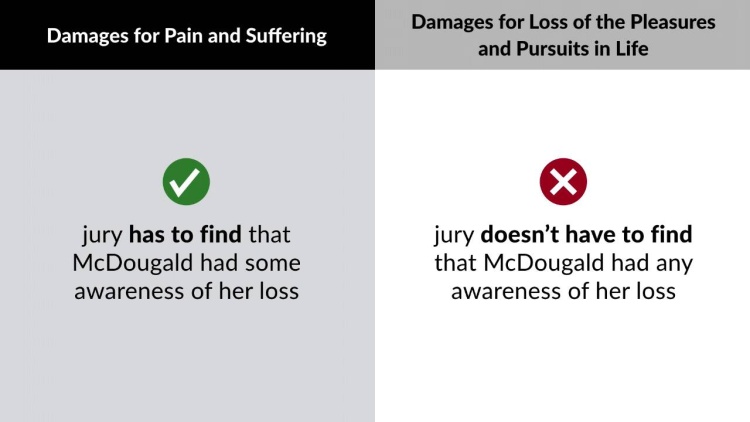McDougald v. Garber
Court of Appeals of New York
73 N.Y.2d 246, 536 N.E.2d 372 (1989)
- Written by Megan Petersen, JD
Facts
Emma McDougald (plaintiff) underwent a Cesarean section and tubal ligation in 1978. The procedures were performed by Garber (defendant), and anesthesia was performed by Armengol and Kulkarni (defendants). During the surgery, McDougald was deprived of oxygen and suffered brain damage leaving her in a permanent coma. McDougald and her husband brought derivative actions against all defendants alleging malpractice. The jury awarded McDougald a total of $9,650,102 in damages, including $1,000,000 for conscious pain and suffering and a separate award of $3,500,000 for loss of the pleasures and pursuits of life. Her husband received $1,500,000. The remainder damages were awarded for economic losses. In a post-trial motion, the trial judge reduced McDougald’s award to $4,796,728 by striking her award for future nursing care and reducing separate awards for conscious pain and suffering and loss of the pleasures and pursuits of life to a single award of $2,000,000. The appellate division affirmed, and the defendants appealed primarily on the issue of the award to McDougald for nonpecuniary damages involving her conscious pain and suffering and loss of the pleasures and pursuits of life. The parties agreed McDougald could not recover for pain and suffering unless she was conscious of her pain. The defendants argued she also could not recover for loss of enjoyment of life unless she was conscious of her loss. The trial court permitted recovery without proof of this consciousness, which is the primary issue raised by the defendants on appeal.
Rule of Law
Issue
Holding and Reasoning (Wachtler, C.J.)
Dissent (Titone, J.)
What to do next…
Here's why 899,000 law students have relied on our case briefs:
- Written by law professors and practitioners, not other law students. 47,000 briefs, keyed to 994 casebooks. Top-notch customer support.
- The right amount of information, includes the facts, issues, rule of law, holding and reasoning, and any concurrences and dissents.
- Access in your classes, works on your mobile and tablet. Massive library of related video lessons and high quality multiple-choice questions.
- Easy to use, uniform format for every case brief. Written in plain English, not in legalese. Our briefs summarize and simplify; they don’t just repeat the court’s language.





